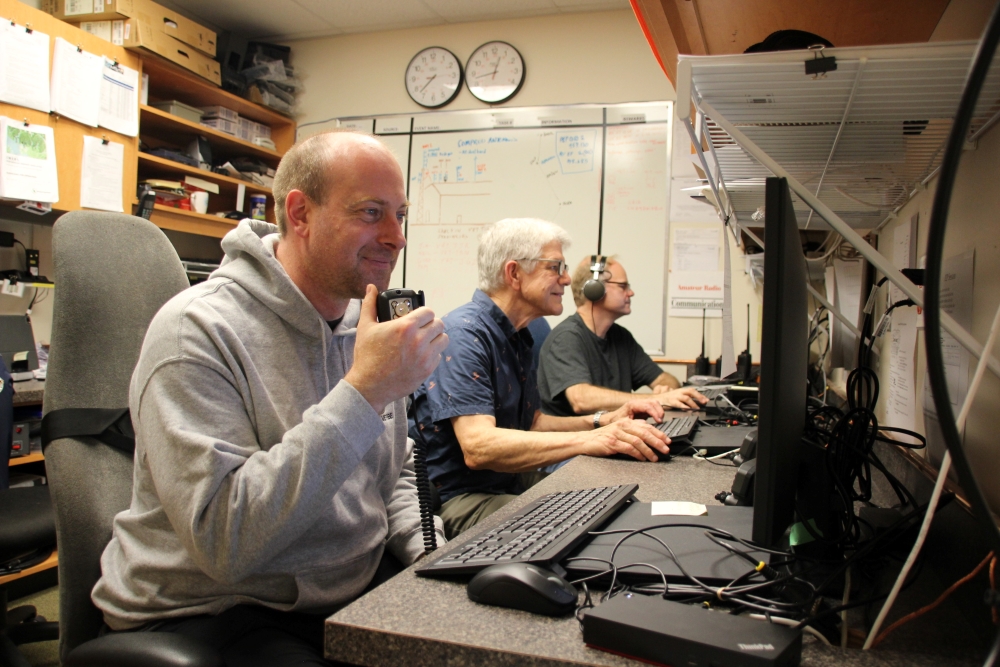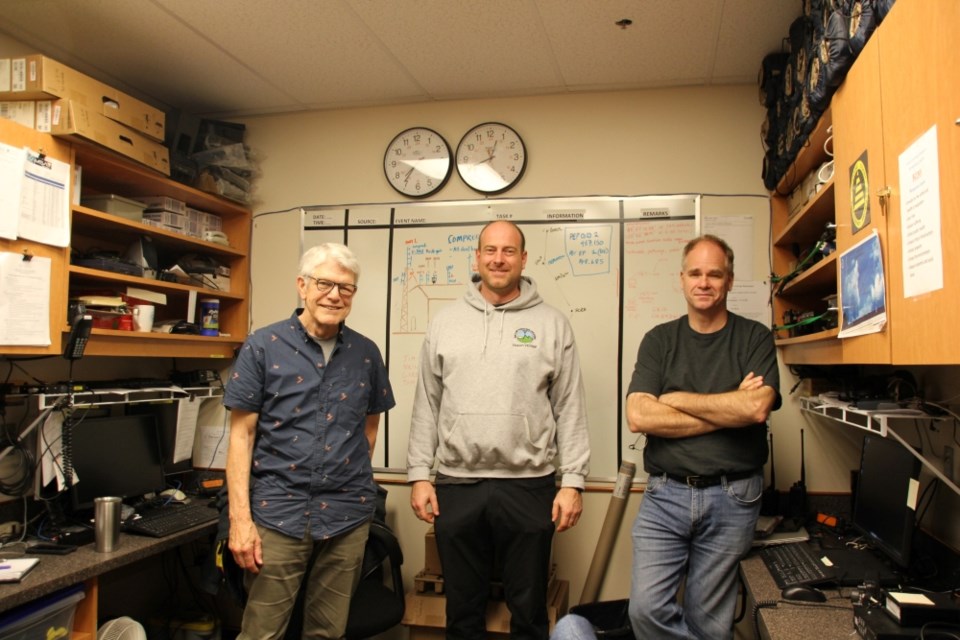Every Wednesday morning, Neil Nicholson — call sign VE7TBN — is one of the volunteers who squeeze into a small windowless room at the Sunshine Coast Regional District’s Field Road office. Surrounded by stocks of first aid supplies, equipment to shelter in place, and desktops, Nicholson checks the radio equipment, contacting part of the Coast’s local network of amateur radio operators over the air.
At the same time, Larry Peterson (VA7LSP) can usually be found in one of the rooms at the Sechelt Seniors Activity Centre, accessing equipment in an enclosed cabinet. He’s had his amateur radio licence since 1967.
“This is sort of the flagship station on the Coast,” Robert Beaupre said of the SCRD’s radio room. Beaupre, call sign VE7RBE, is the president of the Sun Coast Amateur Radio Club Society (SCARCS).
The club has around 30 members from Hopkins Landing to Egmont and everywhere in between, and Beaupre estimates there are more than 100 people with their amateur radio licence on the lower Sunshine Coast. If the internet and phone lines go down, these are the people who can still communicate with the outside world.
“In an emergency, those people [would] probably come out of the woodwork to help. We have very good resources,” he said. Most people with such a licence have their own equipment at their homes, and some have their call signs on their licence plates to signal their skills.
SCARCS maintains two repeaters for the Sunshine Coast that transmit one frequency and rebroadcast on another frequency. The metal tower-like structures must be placed high or where they can provide good coverage. A VHF repeater is located on a hill in Nanaimo (which they maintain in collaboration with an on-island club) and the other, a UHF repeater, is at the Roberts Creek firehall. VHF and UHF are considered local reaches, while HF (high frequency) is for a longer distance. “We’re in a facility that hosts lots of different radio communications equipment that has very good coverage for the entire Coast,” Beaupre said of the repeater in Nanaimo. Club members drive around to regularly test the coverage. “In an emergency that would be the first thing that amateurs would do would be listening and taking direction on that repeater.”
The Roberts Creek repeater provides less coverage but acts as a backup. SCARCS plans to eventually link the two repeaters for more robust coverage.
The amateurs keep their skills sharp by meeting “on air,” which is called a net. Those are hosted locally on Wednesday mornings and Thursday evenings (they like to test different times of the day). They conduct simplex testing, where they communicate on the same frequency that’s not rebroadcast or retransmitted. This system is how they would communicate if the repeaters were not working. By running these tests, club members know which frequencies are likely to work in various emergencies.
Aside from their local net, SCARCS members also meet with nets on Vancouver Island, the Lower Mainland, across the province, western Canada and in the U.S. “We check in sort of a way to keep relationships with the other communities outside the Coast,” Beaupre said.

Besides the SCRD flagship station, there are two more radio stations on the Coast: in an office at Sechelt Hospital and the enclosed cabinet in the Sechelt Seniors Activity Centre. The club is working on setting up a station at Camp Byng for interested Scouts.
Then there are the portable stations that can be used “in the field," which the club uses for demonstrations at public events. These can run on batteries or solar panels.
SCARCS can also send digital messages over radio, such as logistics and provincial emergency forms requesting assistance and describing the situation at hand. As the message transmits, the radio sounds like dial-up internet. It can be used to send an email, and could be used to help community members send messages off-Coast confirming that they are OK.
The messages themselves would be directed by an Emergency Operations Centre (EOC). “Amateurs aren’t making decisions,” Beaupre said. “We’re the conduit.” The SCRD’s Emergency Management Program coordinator, Nancy Hughes, notes all local authorities on the lower Sunshine Coast are trained to become part of Emergency Operations Centre, if activated. If fibre optics were down, the radios could be used to reach South West PREOC (the Provincial Regional Emergency Operations Centre) for logistics, extra resources such as people or equipment, and contacting external partners including BC Ferries and the Ministry of Transportation and Infrastructure.
Hughes points to a recent example, a wildfire in West Sechelt north of Wakefield Creek. Sechelt fire chief Trevor Pike was in touch with Hughes, who let senior leadership know and put people trained for the EOC on standby. She also reached out to other partners to notify them that an EOC may be activated.
“That’s one of the main reasons why we meet up every week here is to check the gateways, and we keep a list of what works,” Nicholson said. And to track whether the frequencies change, Beaupre adds. “The versatility is a big key here.”
In the case of an emergency, the EOC team could relay updates to the reception centres, where the public could go for real-time information. “That would be part of it in the worst case scenario, like borderline Armageddon here,” Hughes said. Amateurs could also set up portable stations in community centres and relay messages from the field to EOC.
The club has not been called upon in an emergency situation, yet, but they are dedicated to staying prepared. On the value the volunteers offer, Hughes said, “First and foremost, it doesn’t matter what agency you are, everybody has a capacity issue. So the more people that are trained, the more people that are prepared. It just makes us so much more resilient, and able to respond.”
So should the general public become amateur radio operators? Not necessarily. Beaupre emphasizes preparing according to provincial recommendations: having a go bag, a neighbourhood plan, and extra supplies to shelter in place.
British Columbia has one of the highest percentages of amateurs per population all across Canada, Peterson points out. The hobby can be varied, from handheld radios for outdoor recreation to trying to communicate with as many countries as possible. Getting a licence isn’t as hard as people think, Nicholson said.
“Most club members are really wanting to share their passion for radio. It's an intersection between their passion and the community, which I think brings a lot of warmth to the heart. You want to feel like your passion is going to contribute to society,” Beaupre said.
People interested in learning more about the Sun Coast Amateur Radio Club Society can find their website at scarcs.ca.



